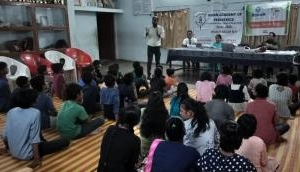Tick-tok: monkey fever is claiming lives & the vaccine is unable to contain it

The virus
- Monkey fever claims more than a dozen lives each year
- It spreads through ticks found in the Western Ghats forest
- Humans can get directly infected
The vaccine
- The only existing vaccine was developed in the 1960s
- It\'s ineffective and caters to a specific age group
More in the story
- Is there enough R&D into improving the vaccine?
- Why has the vaccine not worked?
The Zika virus has grabbed the world's attention and caused much panic as it threatens to spread across the globe. But another virus, as contagious as ebola and more fatal than dengue, is slowly making its way along the Western Ghats.
Monkey fever, known officially as Kyasanur Forest Disease or KFD, was once limited to Karnataka. But cases have now emerged in Goa and Tamil Nadu. Last year it poked its head in Kerala and this year in Maharashtra.
Read- The dengue lesson: private hospitals are buying old beds, not making new ones
Each year monkey fever claims 10-15 lives. Headache, chills, body pain and high fever are some of the symptoms. The only vaccination against it was developed back in the 1960s and is now ineffective.
KFD spreads through ticks found in the forests of the Western Ghats. It was first identified in 1957 in a sick monkey, from the Kyasanur forest of Karnataka's Shimoga district (now Shivamogga). It infects a variety of animals but only monkeys succumb to it. Humans too can get infected directly from ticks by venturing into the forest. The disease is also said to spread from the carcass of infected monkeys -- lending KFD its common name.
This year, seven deaths have been reported from just one taluka in North Goa, and the state's health department has been accused of not carrying out vaccinations. Wayanad district in Kerala, has seen KFD cases since 2013, and last year three persons died.
This year, the disease has inched into Maharashtra for the first time, claiming one life already and infecting 20 others in a village in Sindhudurg district, close to the Goa border. The Marathi daily Loksatta reports that this, coupled with rising instances of monkey deaths in the area have put residents at risk. A team of doctors from Karnataka's Virus Diagnostics Centre have reached the region to find a way to contain the disease.
Not to be taken lightly
Indeed, monkey fever shouldn't be flung aside easily. Although fewer persons get infected with this virus each year (about 300-500 against 10-15,000 for dengue), they have a much higher chance of dying than dengue patients. While fatality rate for monkey fever is between 3-5%, dengue's is less than 0.2 to 0.5%. In fact the worst fatality rate caused by dengue, during the 1996 outbreak, was 3%.
The disease occurs seasonally, from November to March, based on the ticks growth cycle.
The virus is known to affect two kinds of monkeys -- Bonnet Macaque, which is common in South India, and Langoors, which are found across the north and south of the country.
As contagious as ebola and more fatal than dengue, monkey fever is spreading through the Western Ghats
Monkey fever is contagious, although it does not spread between humans. It is currently ranked as Biosafety Level-4, the highest possible risk category for pathogens. The dreaded ebola virus is also ranked Level-4.
A circular put out by the Indian Council of Medical Research way back in 1957 -- soon after the disease's discovery -- says that during initial investigations, "over 100 laboratory persons got infected and suffered with the disease."
The circular was optimistic about controlling the disease, saying that an upcoming facility would come up with diagnostics and vaccines.
But Indians are not sharing that optimism today.
Prevention is better. But the vaccine is bust
The vaccine was developed in the 1960s but its coverage is poor -- even in Karnataka, where the disease was identified more than 50 years ago. Two studies covering the 2006-11 period (one by a state health official and the other by the National Institute of Virology) found that there was a shortage of vaccines.
But that isn't the only problem. The vaccine has never been improved upon its 1960s version.
Also read: Wake up, govt! India's AIDS programme stands on the brink of collapse
It is effective only for the age group of 7-65 years, and several patients are outside this bracket.
Moreover, getting vaccinated is a cumbersome process -- it requires the first two doses to be taken with a gap of one month, followed by boosters every six to nine months.
Not surprisingly, Goa's Health Minister Francis D'Souza told the state's assembly in January that people are not enthusiastic about getting vaccinated.
Catch spoke to G. Arunkumar, head of the Manipal Centre for Virus Research, which has studied the KFD virus and helps diagnose it in parts of the Western Ghats. According to him, "many of the people getting infected are farmers near the forests, who belong to poor families. The vaccination causes pain in the arm, which may be hindering their work. So naturally, the compliance will reduce and so will the coverage of the vaccination."
The vaccine is outdated and cumbersome to take, making it ineffective to contain the spread of the virus
Arunkumar also agrees that there is a need to develop a better vaccine instead of still using what was developed over fifty years ago.
Predictably, studies conducted in the last decade have also found that the vaccine is less effective than before. This was first indicated in a study spanning 2005-2010, when researchers observed that the disease was affecting even those who had been vaccinated, adding that the reasons for this needed to be identified.
There appears to be no development since, despite the number of reported cases increasing. In a recent study of the 2013-14 outbreak by the same authors, the problem of the vaccine not being effective was cited again.
Edited by Anna Verghese
More in Catch:
Jaundice grips Shimla. Blame it on official apathy







![BJP's Kapil Mishra recreates Shankar Mahadevan’s ‘Breathless’ song to highlight Delhi pollution [WATCH] BJP's Kapil Mishra recreates Shankar Mahadevan’s ‘Breathless’ song to highlight Delhi pollution [WATCH]](https://images.catchnews.com/upload/2022/11/03/kapil-mishra_240884_300x172.png)

![Anupam Kher shares pictures of his toned body on 67th birthday [MUST SEE] Anupam Kher shares pictures of his toned body on 67th birthday [MUST SEE]](https://images.catchnews.com/upload/2022/03/07/Anupam_kher_231145_300x172.jpg)






